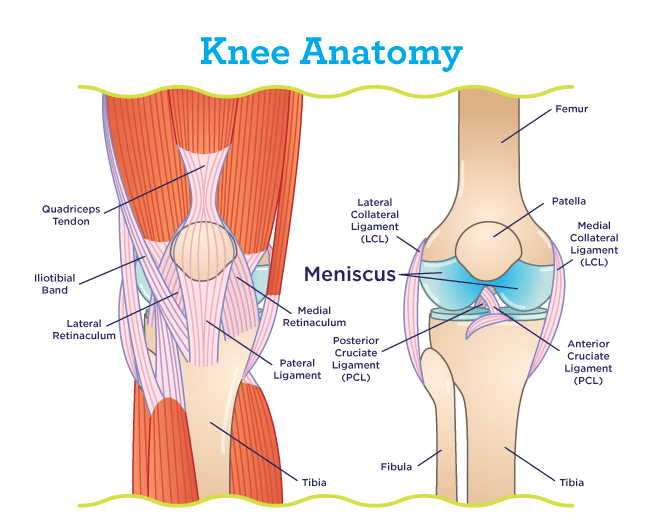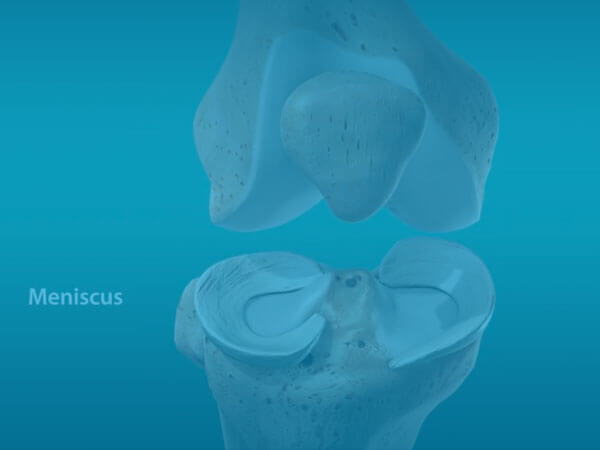10/10/2019
Meniscus tears of the knee are one of the most common problems seen by orthopedic surgeons. The meniscus is a c-shaped pad of cartilage (see diagram) that acts as the shock absorber of the knee and lower stress on the bones and cartilage. It can be pretty painful when damaged.
All patients and meniscus tears are different, and there are many variables when deciding how to treat these tears. The treatment of meniscus tears usually falls into one of two categories:
- A true repair that involves sowing the tissue back together with stitches
- Damage that is not repairable, treated with partial meniscectomy, or trimming out the torn portion of the meniscus
The treatment approach for a particular meniscus tear depends on many factors. For one, there are many different types of meniscus tears – large or small, simple or complex, acute or chronic, associated with arthritis or not, and more. In addition, we have to take into account the location of the tear with regard to its blood supply. If there is no blood supply it may have a hard time healing or “scarring” back together. As you can see, there are many variables to consider and it would be impossible to apply a “one size fits all” type of approach to the treatment of meniscus tears. This is where physician expertise and experience becomes important.
Meniscus Repair
A meniscus repair is typically done with a scope (small incisions for a camera and instruments to perform the repair) by placing stitches, or some sort of fixation, across the meniscus tear much like one would place stitches across a cut in the skin. While we would love to be able to repair all meniscus tears, the truth is that even under ideal circumstances the healing rate of a meniscus repair is only about 80-85 percent. As circumstances deviate from this ideal scenario, the likelihood of a repair healing begins to decline.
When a true meniscus repair is performed, your surgeon is likely to recommend a period of limited weight-bearing (using crutches or walker for walking) and limited motion. They may also recommend using a knee brace. These measures are taken in order to protect the repair and give it a chance to heal.
As this healing occurs, patients progress towards bearing weight, increasing their range of motion, and leaving the knee brace behind. How quickly this progress occurs varies by surgeon, but a typical range is 4-8 weeks. Patients are usually out of the brace and walking without crutches around 2-3 months.
When a patient is able to return to work depends on many factors. If someone has a relatively sedentary job that does not require prolonged periods of standing or walking, they may return to work relatively quickly. On the other hand, if someone has a relatively strenuous job, getting back to full duty at work without restrictions may take 3 months or longer. I see this commonly with construction workers, plumbers, police officers and other physically demanding jobs. Sometimes, the job allows for light-duty restrictions that may allow someone to return to work sooner. As any patient progresses through the rehab protocol, the work restrictions are adjusted until they’re ready to work without restrictions.
Partial Meniscectomy
When a meniscus tear is deemed irreparable, or fairly unlikely to heal with repair, an orthopedic surgeon often recommends a partial meniscectomy. This is actually more common than a meniscus repair. A partial meniscectomy is when a surgeon trims out or removes the torn portion of meniscus leaving behind as much stable, healthy meniscus as possible. While this procedure doesn’t restore the cushioning function of the meniscus, it can significantly improve pain and eliminate or significantly reduce other symptoms such as catching, locking and giving way.
People recover more quickly with no repair that has to be protected in order to heal. They typically use crutches for a few days, but quickly wean off them as the pain and discomfort with weight-bearing disappears. While it is recommended that patients take it easy for the first 10-14 days, they’re typically able to increase activity at their own pace. Those that have office job duties typically return to work within a couple of weeks. Those with more strenuous occupations may get back to full duty around 6-8 weeks.
While the postoperative rehabilitation and restrictions are different between the two procedures, the goal of the surgeon is to help their patients safely get back to the activities they enjoy as soon as possible without jeopardizing the long-term health and function of the knee. An orthopedic specialist can help patients understand their situation, determine whether their meniscus tear might be reparable or not, and what recovery timeline to expect to help them get back to full function as quickly and safely as possible.
Suspect a knee or meniscus problem? Get a quick and accurate diagnosis at OrthoNebraska. Call (402) 609-3000 to make an appointment or visit an orthopedic urgent care.






